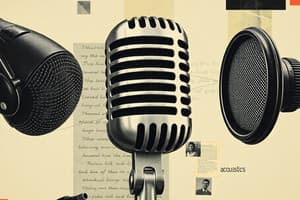Podcast
Questions and Answers
What is the primary feature of a cardioid microphone?
What is the primary feature of a cardioid microphone?
- It captures sound equally from all directions.
- It is most sensitive to sounds from the sides.
- It focuses on sound primarily from the front. (correct)
- It amplifies background noise significantly.
Why is it advisable to use a cardioid microphone for recording vocals with an acoustic guitar simultaneously?
Why is it advisable to use a cardioid microphone for recording vocals with an acoustic guitar simultaneously?
- It requires less power than other types of microphones.
- It eliminates sounds coming from the front completely.
- It minimizes background noise while focusing on the desired sound source. (correct)
- It captures both instruments equally well.
What characteristic does the back of a cardioid microphone possess?
What characteristic does the back of a cardioid microphone possess?
- It is slightly sensitive to sound. (correct)
- It is highly sensitive to all sound sources.
- It captures reverb effectively.
- It is completely insensitive to sound.
Which of the following scenarios would NOT be ideal for using a cardioid microphone?
Which of the following scenarios would NOT be ideal for using a cardioid microphone?
What is a key advantage of using a cardioid microphone when eliminating unwanted noise?
What is a key advantage of using a cardioid microphone when eliminating unwanted noise?
What is the primary function of mic patterns?
What is the primary function of mic patterns?
Which microphone pattern captures sound evenly from all directions?
Which microphone pattern captures sound evenly from all directions?
What characteristic does a cardioid microphone have?
What characteristic does a cardioid microphone have?
What is the main limitation of the Super-Cardioid mic pattern?
What is the main limitation of the Super-Cardioid mic pattern?
Which of the following scenarios is best suited for an omnidirectional microphone?
Which of the following scenarios is best suited for an omnidirectional microphone?
In what type of situations are bidirectional microphones most effective?
In what type of situations are bidirectional microphones most effective?
How do mic patterns influence frequency response?
How do mic patterns influence frequency response?
What aspect of a microphone does the term 'polar pattern' refer to?
What aspect of a microphone does the term 'polar pattern' refer to?
What is the primary function of a microphone?
What is the primary function of a microphone?
Which type of microphone is typically used in loud environments?
Which type of microphone is typically used in loud environments?
What is a key characteristic of condenser microphones?
What is a key characteristic of condenser microphones?
What is another name for a lavalier microphone?
What is another name for a lavalier microphone?
Which type of microphone is best suited for film and video production?
Which type of microphone is best suited for film and video production?
How do soundwaves interact with a microphone?
How do soundwaves interact with a microphone?
What is a shotgun microphone specifically designed to do?
What is a shotgun microphone specifically designed to do?
What distinguishes a dynamic microphone from a condenser microphone?
What distinguishes a dynamic microphone from a condenser microphone?
Flashcards are hidden until you start studying
Study Notes
Microphone Basics
- Microphones are essential devices for capturing and recording sounds, converting sound waves into electrical signals.
- They function as transducers, where sound waves strike the microphone's membrane, generating electrical energy.
Types of Microphones
-
Dynamic Microphones
- Ideal for loud environments due to high durability and sound pressure handling.
- Commonly used in live sound situations.
-
Condenser Microphones
- Best suited for capturing detailed sounds and often used in recording studios.
- Require phantom power to operate effectively.
-
Shotgun Microphones
- Also known as boom mics, designed for directional sound pickup.
- Typically used in film and video production to capture audio from specific sound sources while rejecting ambient noise.
-
Lavalier Microphones
- Small, clip-on mics also referred to as lapel mics.
- Designed for hands-free operation and often used in interviews and presentations to capture dialogue directly from the speaker.
Microphone Polar Patterns
-
Omnidirectional
- Captures sound evenly from all directions.
- Ideal for recording sounds in a room or when using with various sound sources simultaneously.
-
Cardioid
- Captures sound mainly from the front while rejecting sounds from the sides and back.
- Most sensitive at the front, making it ideal for isolating a single sound source, such as a vocal performer.
-
Super-Cardioid
- Similar to cardioid but with a narrower pickup area in the front and some sensitivity at the back.
- Useful for applications where background noise needs to be minimized.
-
Bidirectional
- Picks up sound from the front and back but rejects sounds from the sides.
- Suitable for interviews or duets where two sound sources face each other.
Importance of Microphone Placement
- The selection of microphone polar patterns affects how sound is captured and influences recording quality.
- Understanding polar patterns helps in strategically placing microphones to enhance sound pickup and reduce unwanted noise.
Studying That Suits You
Use AI to generate personalized quizzes and flashcards to suit your learning preferences.




